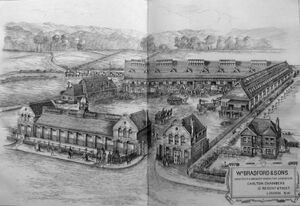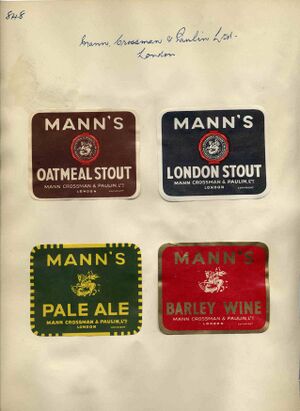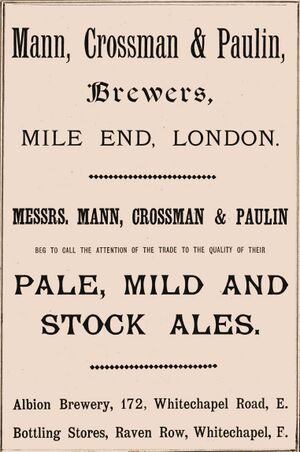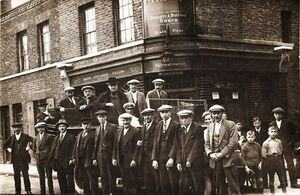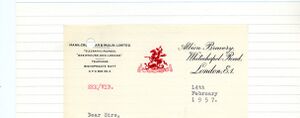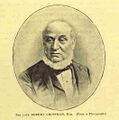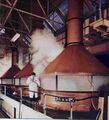Mann, Crossman & Paulin Ltd: Difference between revisions
No edit summary |
No edit summary |
||
| Line 63: | Line 63: | ||
The old brewery premises, originally leased from Richard Ivory were purchased from the estate of his widow in 1860 for £2,150 following which, the Albion Brewery was rebuilt and modernised. In 1863 Pennells Almshouses were bought from the Worshipful Company of Drapers and in 1866 the Blind Beggar and adjoining land in Dog Row, (now the Cambridge Heath Road), was acquired from the executors of a Mr Harwood, a landlord of the Blind Beggar. Therefore at the merger of Mann Crossman & Paulin with Watney Combe & Reid in 1958, the Albion Brewery was one of the largest brewery sites in London. The main brewery fronted the Whitechapel Road, almost opposite the London Hospital and was bounded by Brady Street to the west and the Cambridge Heath Road to the east. The cavernous cellars sheltered hundreds of East Enders during the London Blitz. The bottling stores were to the south of the Whitechapel Road in Raven Row opening into Sydney Street - scene of the famous siege in 1913. The stables for the teams of magnificent shire horses were originally in the Cambridge Heath Road, but as a result of bomb damage, were moved after the war to a former distillery a short distance away in the Mile End Road. | The old brewery premises, originally leased from Richard Ivory were purchased from the estate of his widow in 1860 for £2,150 following which, the Albion Brewery was rebuilt and modernised. In 1863 Pennells Almshouses were bought from the Worshipful Company of Drapers and in 1866 the Blind Beggar and adjoining land in Dog Row, (now the Cambridge Heath Road), was acquired from the executors of a Mr Harwood, a landlord of the Blind Beggar. Therefore at the merger of Mann Crossman & Paulin with Watney Combe & Reid in 1958, the Albion Brewery was one of the largest brewery sites in London. The main brewery fronted the Whitechapel Road, almost opposite the London Hospital and was bounded by Brady Street to the west and the Cambridge Heath Road to the east. The cavernous cellars sheltered hundreds of East Enders during the London Blitz. The bottling stores were to the south of the Whitechapel Road in Raven Row opening into Sydney Street - scene of the famous siege in 1913. The stables for the teams of magnificent shire horses were originally in the Cambridge Heath Road, but as a result of bomb damage, were moved after the war to a former distillery a short distance away in the Mile End Road. | ||
About 1956 Manns made their last acquisition when they bought a privately owned group of public houses in and around Coventry. As Manns draught beers (I.P.A., K.K., and X) did not appeal to the Midlands’ palate a reciprocal agreement was reached with [[Atkinson's Brewery Ltd]] of Birmingham, whereby Manns midlands’ trade stocked Atkinsons’ draught beers and Atkinsons houses sold Manns’ premium bottled beers, Manns Brown Ale, Cream Label Stout and Rustic Ale. Whilst Cream Label and Rustic have long since disappeared, Manns Brown Ale remains the market brand leader. The following companies were wholly owned subsidiaries but are now just names from a distant but distinguished history:- | About 1956 Manns made their last acquisition when they bought a privately owned group of public houses in and around Coventry. As Manns draught beers (I.P.A., K.K., and X) did not appeal to the Midlands’ palate a reciprocal agreement was reached with [[Atkinson's Brewery Ltd]] of Birmingham, whereby Manns midlands’ trade stocked Atkinsons’ draught beers and Atkinsons houses sold Manns’ premium bottled beers, Manns Brown Ale, Cream Label Stout and Rustic Ale. Whilst Cream Label and Rustic have long since disappeared, Manns Brown Ale remains the market brand leader. The following companies were wholly owned subsidiaries but are now just names from a distant but distinguished history:- | ||
Revision as of 21:34, 7 July 2019
Mann, Crossman & Paulin Ltd, Albion Brewery, Whitechapel Road, London E1
The Albion Brewery was built in 1808. Became Blake & Mann in June 1819 and James Mann was in control in 1826. Crossman and Paulin became partners in 1846. Registered October 1901.
Merged with Watney, Combe, Reid & Co. Ltd in 1958 to form Watney Mann Ltd. The Albion Brewery closed in 1979. Parts remain standing.
Even after the closure of Mann's brewery, the company became a trading division of the Watney-Mann group, and the company's 'George & Dragon' trade mark became a common feature on pub signs in Britain, even in areas many miles removed from the original trading area.
Takeover and closure trail:
- In 1919 they acquired the Stamford Hill Brewery, Michell, Goodman, Young & Co. Ltd.
- Brandon's Brewery Ltd of Putney were acquired in 1920 with 76 public houses. Ceased brewing 1949 but remained open as bottling store for some time.
- Best's Brewery Co. Ltd of Clapham, London SW4 were acquired in 1924 with 6 tied houses.
- The Hornchurch Brewery Co. Ltd was acquired in 1925, and brewing ceased there in 1929.
- In 1929, they acquired Henry Luker & Co. Ltd, Middleton Brewery, Southend-on-Sea with 43 public houses for £285,000.
- Benjamin Bennett's Dunstable brewery was acquired in 1938 with 59 tied houses. Brewery demolished 1971.
Mann, Crossman & Paulin Ltd, Albion Brewery, Shobnall Road, Burton-on-Trent, Staffordshire.
See Mann, Crossman & Paulin (Burton)
The Burton brewery was built 1875 by Mann, Crossman & Paulin and used by them until 1896. Sold to Marston, Thompson & Evershed Ltd in 1902.
Jimmy Bird writes:-
There was a brewhouse adjoining what is now the Blind Beggar public house from sometime in 1673. The Blind Beggar was near the Mile End Turnpike and the brewhouse is thought to have been part of the freehold. The brewhouse was known to lay behind the inn close to the Worshipful Company of Draper’s, “Pennells Almshouse” on what was “Simpkins Ground”. The history of the Blind Beggar is hazy, but in 1807 a Mr Richard Ivory was the landlord. He decided to enlarge the brewhouse and this eventually led to the building of a completely new brewery. The advertisement featured by Dr Smith is the very beginning of the Albion Brewery. The next step was to find a suitable Brewer/Tenant and to this end there appeared the following newspaper advertisement:-
The bidding failed to reach an acceptable offer and it is not until September 1809 that -a permanent Brewer/Tenant is listed in the local directories. He is shown as “John Hoffman, Brewer, Albion Brewery, 172 Whitechapel Road, London”.
Within six years Hoffman found himself in financial difficulties and unable to comply with the terms of his lease from Richard Ivory. As a solution, Hoffman mortgaged his business to a Henry Chase, “brewer of Chelsea and Leyton”, for £2,237: 16 2d. This was not entirely successful as in 1817 Hoffman arranged a second mortgage from William Daniels “Maltster of Bishops Stortford”. This, too, was unsuccessful and in 1818 both Hoffman and Daniels were declared bankrupt.
On the 10th June 1819, the Albion Brewery was put up for sale and knocked down for £2,420 to Philip Betts Blake. Blake was the senior partner of P. Blake & Co, Standbridge Brewery, Narrow Wharf, Lambeth. James Mann was the junior partner. Upon the purchase of the Albion Brewery, the company changed its name to Blake & Mann. In 1826 Blake retired and sold his interest in the company to James Mann for a nominal £100. Blake died in 1834. James Mann was now the sole proprietor of the brewery and in 1843 his sons, James and Edward were admitted as junior partners.
Thomas Mann was the third and youngest son of James Mann senior. Whilst employed within the brewery he was not given a partnership until his twenty-fourth birthday. Edward Mann died from typhus some three weeks before the death of his father in 1844.
James Mann junior, now in sole possession, realised he needed an experienced and practical working partner to ensure the successful progression of the business. Robert Crossman was just such a man. Robert Crossman was introduced to James Mann by Dr John Gibson, a mutual family friend, and became a fully fledged partner in 1846. Crossman, who at the time was managing the Border Brewery, Berwick on Tweed, bought a quarter share of the company for £10,000 plus £2,500 for goodwill.
Robert Crossman was a great friend of Thomas Paulin, who also hailed from Berwick on Tweed. The two of them had served together at the Isleworth Brewery - much later to become part of the Watney Mann empire. Thomas Paulin became a partner in September 1846. The company traded as “Mann Crossman” and I understand it was not until 1847 the name was changed to “Mann Crossman & Paulin”
In 1847 James Mann retired leaving Thomas Mann as the remaining family partner.
The old brewery premises, originally leased from Richard Ivory were purchased from the estate of his widow in 1860 for £2,150 following which, the Albion Brewery was rebuilt and modernised. In 1863 Pennells Almshouses were bought from the Worshipful Company of Drapers and in 1866 the Blind Beggar and adjoining land in Dog Row, (now the Cambridge Heath Road), was acquired from the executors of a Mr Harwood, a landlord of the Blind Beggar. Therefore at the merger of Mann Crossman & Paulin with Watney Combe & Reid in 1958, the Albion Brewery was one of the largest brewery sites in London. The main brewery fronted the Whitechapel Road, almost opposite the London Hospital and was bounded by Brady Street to the west and the Cambridge Heath Road to the east. The cavernous cellars sheltered hundreds of East Enders during the London Blitz. The bottling stores were to the south of the Whitechapel Road in Raven Row opening into Sydney Street - scene of the famous siege in 1913. The stables for the teams of magnificent shire horses were originally in the Cambridge Heath Road, but as a result of bomb damage, were moved after the war to a former distillery a short distance away in the Mile End Road.
About 1956 Manns made their last acquisition when they bought a privately owned group of public houses in and around Coventry. As Manns draught beers (I.P.A., K.K., and X) did not appeal to the Midlands’ palate a reciprocal agreement was reached with Atkinson's Brewery Ltd of Birmingham, whereby Manns midlands’ trade stocked Atkinsons’ draught beers and Atkinsons houses sold Manns’ premium bottled beers, Manns Brown Ale, Cream Label Stout and Rustic Ale. Whilst Cream Label and Rustic have long since disappeared, Manns Brown Ale remains the market brand leader. The following companies were wholly owned subsidiaries but are now just names from a distant but distinguished history:-
- Brown & Pank Ltd, Wine & Spirit Merchants
- Kershaw & Cressey Ltd, Multiple Off-Licences
- St Georges Taverns Ltd, Managed Houses
The London brewery features in The Noted Breweries of Great Britain and Ireland by Alfred Barnard published 1890.
The Burton brewery features in The Noted Breweries of Great Britain and Ireland by Alfred Barnard published 1890.
Various images of the brewery
An assortment of images of the Mile End Brewery taken during a BHS Urban Walk in 2009. Courtesy Steve Peck.
|


